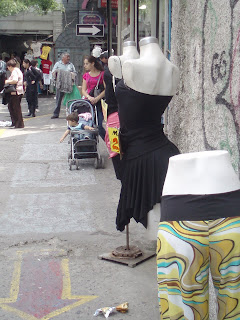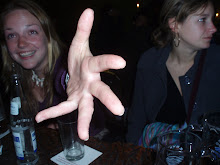I am referring to December 8th, Catholocism's day to recognize the Immaculate Conception. All across Latin America, different countries take a different spin on the eigth. In Columbia, candles are lit simultaneously in all (participating) houses, representing light of Christ and also solidarity amongst families and neighbors. In Mexico, the day blends with the Saint Day of Juan Diego Cuauhtlatoatzin, an indigenous Mexican canonized in 2002 for being the witness of the apparition of Nuestra Senora de Guadalupe, who is celebrated herself later this week on the 12th. Worshippers also turn out to visit the Virgen de Juquila, in Oaxaca, pledging various numbers of future visits in return for favors and miracles. In Paraguay, the faithful make their way to see the Virgen de Caacupé, a sculpture of Mary made in the 1800s. The legend holds that the artist was wandering outside the city, looking for suitable materials for his work, when he was surrounded by a hostile tribe from the area. He promised to create a statue in honor of the Virgen if she would save his life, and upon emerging from the situation without harm, immediately did so.
In Chile, or at least in the Central Valley, there are two main celebrations on December 8th. The first is far more famous and is the culprit behind my long weekend. Each year, Route 68, which connects Santiago to Valparaiso, is closed for the majority of its distance to make room for several hundred thousand pilgrims who make the 60-kilometers or so walk from Santiago to the temple of La Virgen de Lo Vasquez. The temple is located just outside the small town of Casablanca, about 30 kilometers south-east of Valparaiso. This pilgrimage attracts yearly media coverage, as it is a popular show of penance amongst the most deliriously devoted to crawl the last few kilometers along the concrete to the shrine.
The other celebration takes place within Santiago, in the Quinta Normal area. This is where the impressively large Santuario de Lourdes, officially designated as a "minor basilica," maintains a forceful if not exactly graceful posture over the surrounding residential neighborhood. Across from the church's entrance, a man-made grotto holds images of the Virgen, and a near-by fountain pumps out holy water by the gallon.
Riding the bus to Santiago on Saturday, pilgirms were already in evidence along the road. One young couple waved at the bus and pumped a Chilean flag with a surface area close to that of my dining room table. Families had set up tents and were lounging after hours on the road. Small children swam and played in the trickle of a river that runs alongside the road, in the midst of horses grazing and plastic bags floating along. At the turn off for the Sanctuary, every available spot on the grass was already filled with tents and vendors' collapsible stalls. I began to see that my return was going to be more complicated than I thought. On my arrival, I confirmed it: I could get back, but it was going to take several hours due to the road closure.
After an interesting and enjoyable Santiago weekend, I awoke on Monday determined to make it to Lo Vasquez. First, though, I needed to eat. I had taken a room near La Moneda, so I wandered into the pedestrian streets near Plaza de Armas. Normally packed with people shopping and eating, even performing illegal lip-syncing shows, the streets were filled with one shuttered store after another. Interestingly enough, while going to the mall or stopping in at a restaurant are apparently not appropriate activities for a holy day, major stores Paris and Ripley seem convinced that the Virgin won't take offense if you stop in at their electronic branches to pick up a new TV. It also seems that completos and other fast food are the preferred nutrition for such a day.
I began to get a little bit desperate for some sort of food with at least a minor vitamin content when I had a flash of inspiration. Where, in the United States, is it always possible to eat on Christmas? Chinese food! I rushed off to one that I knew of and was happily enjoying a veggie chop suey within half an hour.
Following this (and an ice cream, and a lounge in the Parque Forestal--I'm not Catholic, after all, and I expect a bit of relaxation from my days off no matter what the cause) I took the metro out to Quinto Normal. After asking around, it had become apparent that if I wanted to go to Lo Vasquez from Santiago, I was going to have to walk it. My curiousity was not that strong, so at the end of the metro line I walked through the park and arrived on Calle Lourdes.
The scene was not what I expected. All along the street, people had set up tents and camper vans, as in Casablanca. These were not pilgrims, however; they were vendors. And oh what vendors--used clothing, cosmetics in bulk, cheaply made shoes, antique or simply worn down knick-knacks, it was all there. In fact, it was not much different from Valparaiso's weekend flea market on Avenida Argentina, where it is guaranteed that any strange missing part from any given appliance can be found if you have enough patience.
Once I entered the church yard, the scene was equally tacky but with a bit more religious flavor. Here, one can obtain a bottle for holy water in the shape of the Virgin Mary, with a screw cap perched oddly on the top of her head. There are also, of course, plastic statues of the lady of all variety of sizes, ranging from dashboard to lawn shrine, in my estimation. The same vendors offered diorama-esque representations of the Virgin appearing in a grotto, with a surprised plastic doll saint gazing upon her in wonder. These were also available in desktop through display case sizes.
One ubiquitous product that seemed a bit more pure of heart was small sheaves of wheat, affixed with a small card with an image of Mary. I approached a man to ask about the significance.
"It's wheat," he answered. I was aware, I told him, but could he tell me what it was used for?
With a helpful but confused look, he explained to me, "Lots of things! Bread, cookies, cakes...."
I cut him off. "What is the religious significance? Why is it being sold today at the church?"
He looked at me for a moment and then shrugged. "No idea," he said amiably.
To be fair, I would imagine that most people buying wheat stalks at a church have some purpose in mind, and are not inclined to ask for directions. In researching after the fact, I found two possibilites. First, wheat, together with grapes, symbolizes the Eucharist since it is used to make the unleavened bread that represents the body of Christ. Secondly, there is a parable from Matthew that equates Christians with wheat (useful, good) and non-believers as weeds (bad, not good for much). At the time of "harvest," i.e. the end of the world, the angels will act as reapers and take the "wheat" off to heaven. Out of the two of these, I'm more inclined to think that the wheat available in Santiago is linked to the second symbol, since the Virgin is meant to represent purity and goodness. In my limited understanding of things, the Eucharist is a purely Christ-based thing and as such seems an odd thing to invoke for a day centered on his mother--unless it's a reference to the Immaculate Conception itself, which I suppose is the initiation of the body of Christ.
Inside the constructed grotto, mass was being said. I watched for a while and then made my way over to the holy water fountain, an oddly automated version of a traditional rite, at least from my perspective.

 Unfortunately, with a dead camera battery, I was unable to capture any more of the scene. Given that I had no baptism to reflect on, as the sign instructed me, I simply stood back and watched as waves of people climbed around on the rock, filling 2 and 3 liter bottles with holy water.
Unfortunately, with a dead camera battery, I was unable to capture any more of the scene. Given that I had no baptism to reflect on, as the sign instructed me, I simply stood back and watched as waves of people climbed around on the rock, filling 2 and 3 liter bottles with holy water.Around the corner, plaques from the contemporary to the distant past record the thanks of visitors whose requests of the Virgin were granted. It is the proper etiquette: if a favor is granted, the worshipper has a responsibility to return and have a stone engraved thanking the saint in question.





































